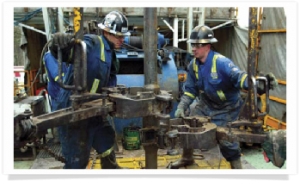Benefits of ISO 9001: Drilling Contractor Uses ISO 9001 as Catalyst For Growth
This case study provides an overview of the benefits of an ISO 9001 quality management system, which was designed for the international division of the largest drilling contractor in the world, based in Houston, Texas. The QMS covered all aspects of business and drilling operations, including quality assurance and control.

Prior to the implementation of the TQM, the company operated 30 rigs, in about 13 different countries with approximately 1k employees. The company embarked upon a growth strategy over 5 years through mergers and acquisitions and quickly grew to operating over 100 drilling and work over rigs, which spanned 6 continents and 23 countries and included over 5k employees.
The company almost immediately started to encounter challenges such as, cultural differences of the merged organizations, cultural differences between the various 23 countries, the challenges of expatriate managers not understanding local cultures, language barriers, resistance to change, differences in business practices, poor rig maintenance practices, poor rig operations, poor safety practices, logistical challenges and ultimately the need to reduce cost and the local demand to train and promote local employees.
Within the first 5 years of the M&A, the company started to notice an increase in rig maintenance costs, increase in incident and fatality rates, equipment and parts being delayed in customs due to improper paperwork, increase in rig downtime and equipment failure, rig blow-outs, oil company complaints, changing demands of the industry and a myriad of other problems. The growth the company was pursuing was now in danger of impacting shareholders and the company was put on notice to take immediate corrective action.
Through strategic planning, the company quickly realized that their current management systems could not support their growth. The conclusion was that the company needed to implement robust quality, health, safety, environmental and operational management systems to assist in stabilizing the company, to provide a framework and establish a baseline of standard processes and procedures throughout the organization.
Project Scope
The scope of the TQM implementation project, was to design, develop and implement a comprehensive management system that would provide a framework and baseline for all 23 countries and 100 plus rigs. The quality portion of the TQM would be based upon the requirements of ISO 9001, the safety was based upon OHSAS 18001 and the environmental was based upon ISO 14001. The operational components would be based upon industry and the company’s best practices.
Planning
To accomplish these objectives a comprehensive study was performed on defining and categorizing the company’s critical success factors (CSF). Upon numerous brainstorming and strategy sessions, the company developed a structure that encapsulated all aspects of its operation.
Design
The final design and structure of the TQM included a 3 level management system that included processes and procedures for the company’s Headquarters, Local Offices and Rig Operations. Each tier included elements to capture processes and procedures at each level. Each level included approximately 13 elements. The entire TQM ultimately included approximately 39 elements. The elements were given clear names that employees could relate to, such as Reporting, Human Resources, Rig Moves, etc.
The company now had a robust framework to design its processes and procedures within. The actual processes and procedures were defined and documented through teams, reviewed and approved by process owners prior to issue. Upon approval, the documents were translated into the various languages. The documents were then issued as sets of controlled manuals. Manuals were released for use upon being published.
Implementation
Upon the system documents being issued, the system was implemented at each level. The implementation included a very thorough roll out in the various countries, which included training, coaching and actual hands-on implementation assistance to help employees properly implement the processes and procedures. Upon implementation, the location was given approximately 3 – 6 months to fully implement the TQM. After this period an internal auditing program was established to continually enforce the newly issued processes and procedures.
A performance monitoring system was also established, which measured key performance indicators on a monthly basis. Employee incentives were also tied to these performance indicators, to continually provide motivation to maintain the improvement that was achieved.

Realized Benefits
Upon successful implementation, which was accomplished over a 3-4 year period, the company experienced many tangible and sustainable benefits of ISO 9001, which included:
- Increased revenues from $100M to $250M within 5 years, with a goal to achieve $1B within the next 5 years.
- Consistent 10-15% profit margin
- Reduction in rig downtime by 50-60%
- Reduction in recordable incidence rates by 20%
- Reduction in worker’s compensation costs of approximately $500k – $1M per year
- Ability to reduce labor cost by capturing best practices and use local labor
- Recognized for various drilling records without incident
- Recognized for fastest rig moves in various countries
- Improved image
- Employees became more comfortable and confident, as they now had guidelines
- Ability to become more nimble when change was necessary
- Better understanding and tolerance of cultural issues
- Establishment of a baseline and a balance scorecard
The TQM became the model for the entire company and elements of the system was implemented in the company’s domestic operations.
Lessons Learned
There were many lessons learned during the project, but some of the main lessons are as follows:
- The company realized that the maintenance of a hard copy manual system was difficult to manage. The TQM was ultimately converted into an online and compact disc (CD) format, but this was after a substantial amount of money had been incurred on print media. Companies should establish a functional, reliable and accessible Internet based document management system for employees to access management system documents.
- The system was developed using subject matter experts (SME), but it would have benefited from having some actual line employees provide direct input during the creation of the processes and procedures. The SMEs sometimes had a tendency to document best practice versus how thing were actually done. This caused some issues due to the inability to correctly diagnose problems. Its best to document processes and procedures how they actually are and then change. Changes can be made during another phase, which provides for more analysis of the root cause of problems and better change management. A good analogy would be if a patient improved their eating and exercise habits for 1 month prior to going to visit their doctor and all the lab results were normal. After the visit the patient returns their poor habits. This does not give the doctor the opportunity to see a true picture and make a proper diagnosis. This was ultimately overcome through employee feedback systems and internal audits.
- This type of effort must be properly staffed to ensure sustained success. This can be accomplished through direct or contract labor, but the implementation and maintenance of a management system is an ongoing effort that requires infrastructure and resources. This company initially attempted to undergo the project with a 1 person team, which lengthened the development phase and also the time before the company was able to start having a positive return on investment. Traction was realized only when the appropriate infrastructure was put in place, which included direct and contract resources.
Conclusion
In conclusion, we can see that there are many tangible benefits of ISO 9001 and understand that a quality management systems, can be used as the foundation for growth. Without sound management systems in place, companies that attempt to grow will encounter many unforeseen and avoidable challenges that may counter the benefits of the growth strategy.
